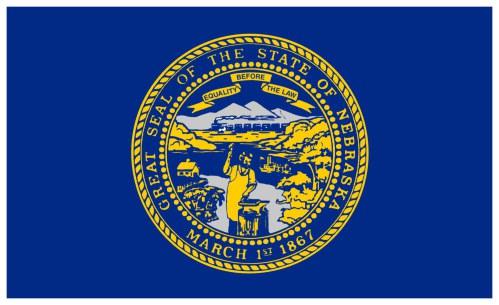
Flag of Nebraska, USA
January
Weather in January
January is the coldest month of the year in Nebraska, with the northeast typically being the coldest region of the state. The western panhandle generally has lower average temperatures during the rest of the year, but in January, the entire state experiences a firm grip of cold weather. Minimum temperatures range from 10°F (-12.2°C) to 20°F (-6.7°C), and maximum temperatures hover around the freezing point.
The state receives snowfall that ranges from 21" (533mm) in the south to 45" (1143mm) in the northwest, with the potential for blizzards to disrupt daily life. Comparatively, the temperatures in January are significantly lower than those in December and will remain on the colder side through February. Cold fronts are standard, and strong gales blow without the barriers of mountains to mitigate them. The weak sunlight lasts for only a few hours during the short winter days. The influence of Chinook winds warms the western portion of the state slightly but does not alleviate the overall chill of this winter month. Extreme values were recorded at Camp Clarke, with the lowest temperature of -47°F (-43.9°C) on February 12, 1899, giving an indication of the severe cold that can be experienced during this period.
The state receives snowfall that ranges from 21" (533mm) in the south to 45" (1143mm) in the northwest, with the potential for blizzards to disrupt daily life. Comparatively, the temperatures in January are significantly lower than those in December and will remain on the colder side through February. Cold fronts are standard, and strong gales blow without the barriers of mountains to mitigate them. The weak sunlight lasts for only a few hours during the short winter days. The influence of Chinook winds warms the western portion of the state slightly but does not alleviate the overall chill of this winter month. Extreme values were recorded at Camp Clarke, with the lowest temperature of -47°F (-43.9°C) on February 12, 1899, giving an indication of the severe cold that can be experienced during this period.
- Omaha - January »
In Omaha in January, during 8.8 snowfall days, 2.17" (55mm) of snow is typically accumulated. In Omaha, in January, snow falls for 8.8 days, with typically accumulated 2.17" (55mm) of snow. - Lincoln - January »
The month with the most snowfall in Lincoln is January, when snow falls for 5.1 days and typically aggregates up to 0.83" (21mm) of snow. The month with the most snowfall in Lincoln is January, when snow falls for 5.1 days and typically aggregates up to 0.83" (21mm) of snow. - Bellevue - January »
In Bellevue during January, snow falls for 8.5 days and regularly aggregates up to 1.77" (45mm) of snow. In Bellevue, Nebraska, in January, snow falls for 8.5 days, with typically accumulated 1.77" (45mm) of snow. - Grand Island - January »
The month with the least rainfall in Grand Island, Nebraska, is January, when the rain falls for 3.7 days and typically collects 0.51" (13mm) of precipitation. The months with the lowest UV index in Grand Island are January, February, November and December, with an average maximum UV index of 2. - Kearney - January »
The month with the least rainfall in Kearney is January, when the rain falls for 5 days and typically collects 0.39" (10mm) of precipitation. January, with its high-temperature average of 33.8°F (1°C) and a low-temperature average of 10.4°F (-12°C), is the coldest month in Kearney. - Fremont - January »
The month with the least rainfall in Fremont, Nebraska, is January, when the rain falls for 3.3 days and typically collects 0.71" (18mm) of precipitation. With an average relative humidity of 80%, January is the most humid month in Fremont, Nebraska. - North Platte - January »
The month with the least rainfall in North Platte is January, when the rain falls for 5.5 days and typically collects 0.43" (11mm) of precipitation. The month with the least sunshine in North Platte is January, with an average of 6.1h of sunshine. - Columbus - January »
The month with the most snowfall in Columbus is January, when snow falls for 7.7 days and typically aggregates up to 2.83" (72mm) of snow. January and February are months with the least rain in Columbus when the rain falls for 3.3 days and typically aggregates up to 0.67" (17mm) of rain. - Papillion - January »
January in Papillion is typically the coldest month of the year and significantly chillier than the upcoming February. Papillion's temperature records reveal January as the coldest month, marked by average highs of 30.7°F (-0.7°C) and lows of 16.9°F (-8.4°C). - La Vista - January »
The month with the least rainfall in La Vista is January, when the rain falls for 4.3 days and typically collects 0.51" (13mm) of precipitation. January stands out as La Vista's coldest month, with temperatures ranging between an average high of 30.7°F (-0.7°C) and a low of 16.9°F (-8.4°C).
Updated: May 24, 2024
Published by: Weather U.S. | About Us
Data Sources | Weather Forecasting & Climate
Published by: Weather U.S. | About Us
Data Sources | Weather Forecasting & Climate